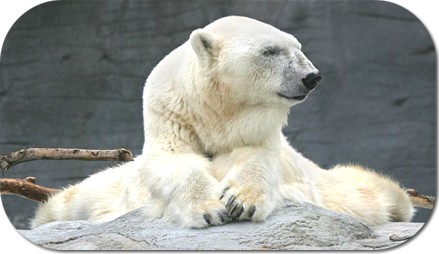
Debby’s Story - A Special Polar Bear and her Legacy
By Dr. Robert E. Wrigley
On November 17, 2008, a sad decision was reached by Veterinarian Dr. Chris Enright at the Assiniboine Park Zoo in Winnipeg (Manitoba, Canada) -- to euthanize a senior Polar Bear named Debby. Weighing over 300 kg in her prime, she had lost considerable weight, multiple-organ failure gave no hope for recovery, and her quality of life was no longer acceptable.
Now, the death of an animal among the Assiniboine Park Zoo’s collection of 2000 specimens of 410 species is not an unusual occurrence, but Debby was no average animal – in fact, she was special in so many ways. The news of Debby’s declining health earlier that year, and her subsequent passing, made media headlines around the world, for she had been widely known as the world’s oldest-living Polar Bear, a feat that was noted in the 2008 Guinness World Records Book. Internet search engines at the time listed dozens of pages of articles about Debby, and public reaction was amazing in the form of letters, emails and phone calls, from across Canada and elsewhere. At 42 years, she was among the top-three record holders for longevity among all eight species of extant bears; a female from Detroit Zoo lived to 43 years, 10 months and a female from Johannesburg reached 42 (Weigl 2005). In the wild, if a Polar Bear survives the high-mortality rate of its first year, it is doing well to live 10-18 years, and it is exceptional for one to reach 30.
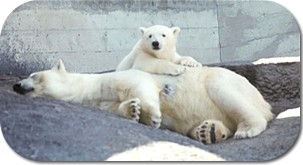 Debby’s story began in late 1966 with her birth in the Russian Arctic, and the following spring she was orphaned (circumstances unknown, but likely her mother was shot), rescued, and sent to the Assiniboine Park Zoo (along with a male cub), arriving on September 6, 1967. Given the name Debby, she quickly became the most-popular animal at the Zoo, and was without a doubt the most-famous and -loved animal in the Zoo’s 104-year history. Children, especially, responded to this bear’s motherly appearance. Playful by nature even in her later years, she demonstrated a remarkable ability to strike photogenic poses when her many admirers came back to visit. Over the years, more than18 million people stopped in their tracks to watch this beautiful white animal frolic in her pool, search for snacks, enjoy a shower, and raise her six young. She spent most (28 years) of her long life with her huge compatible mate Skipper, who died at 34 years, a respectable age for a male Polar Bear.
Debby’s story began in late 1966 with her birth in the Russian Arctic, and the following spring she was orphaned (circumstances unknown, but likely her mother was shot), rescued, and sent to the Assiniboine Park Zoo (along with a male cub), arriving on September 6, 1967. Given the name Debby, she quickly became the most-popular animal at the Zoo, and was without a doubt the most-famous and -loved animal in the Zoo’s 104-year history. Children, especially, responded to this bear’s motherly appearance. Playful by nature even in her later years, she demonstrated a remarkable ability to strike photogenic poses when her many admirers came back to visit. Over the years, more than18 million people stopped in their tracks to watch this beautiful white animal frolic in her pool, search for snacks, enjoy a shower, and raise her six young. She spent most (28 years) of her long life with her huge compatible mate Skipper, who died at 34 years, a respectable age for a male Polar Bear.
As the inevitable day approached, a counselor was invited to address the Zoo staff to discuss what emotions and behaviour people might expect when a relative or favorite pet dies. During the last moments of Debby’s life, many staff members filed by to say their farewells. Several zookeepers had taken care of her for one to two decades, and she had been at the Zoo longer than any of the Zoo’s employees. Consequently, it was a very emotional time for all that knew this gentle giant. As she slumped down for the last time, under anesthesia, there were few dry eyes among the staff in attendance. When it was safe to enter her enclosure, two of her long-time zookeepers were permitted to stroke Debby in a comforting gesture – something of course they had never been able to do before.
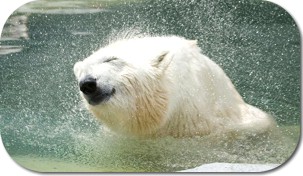 A tribute to Debby was held on the following Saturday afternoon, which drew hundreds of people (in spite of a nasty wind-chill) wishing to say goodbye and to celebrate her life and achievements. The media was also out in full force, covering every aspect of this touching story. As attendees wearing “I Love Debby” t-shirts munched on donated cakes and cookies adorned with Debby’s image, a video was shown highlighting Debby’s life. This video was featured again days later during intermission at a children’s concert (based on a Polar Bear story book) by the Winnipeg Symphony Orchestra. By this time, over a thousand people had signed and left notes for Debby on a 5-metre-long vinyl banner.
A tribute to Debby was held on the following Saturday afternoon, which drew hundreds of people (in spite of a nasty wind-chill) wishing to say goodbye and to celebrate her life and achievements. The media was also out in full force, covering every aspect of this touching story. As attendees wearing “I Love Debby” t-shirts munched on donated cakes and cookies adorned with Debby’s image, a video was shown highlighting Debby’s life. This video was featured again days later during intermission at a children’s concert (based on a Polar Bear story book) by the Winnipeg Symphony Orchestra. By this time, over a thousand people had signed and left notes for Debby on a 5-metre-long vinyl banner.
Dr. Gordon Glover – Zoo Director and the former veterinarian that had cared for Debby for so many years -- began the ceremonial proceedings, followed by an Elder who said that Debby’s spirit would continue to live on. Stirring songs were sung by a group of First Nations women, to the beat of a large White Bear Drum, and then zookeepers and public admirers came to the podium to offer their favorite remembrances of Debby. The entire event was a remarkable outpouring of caring for a true icon. Many Zoo visitors, who were youngsters when they first began visiting Debby in the 1960s, were here again with their own grandchildren, many of which carried little stuffed replicas of Debby in their arms.
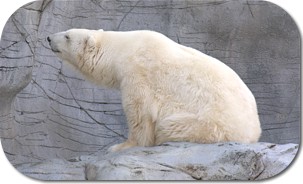 Debby was a wonderful ambassador for her species, and contributed much to sensitizing people about the need to conserve Arctic wildlife and ecosystems. Public and international concern about the serious consequences of global warming would not have reached its current level without the dire threat to Polar Bear populations. Debby stimulated the writing of a popular book on Polar Bears (Wrigley 2001) which included a chapter on Polar Bears in zoos, two children’s books, and she also played a role in several research studies, such as one investigating stress-hormone levels in captive Polar Bears (supported by the United States Association of Zoos and Aquariums). Numerous husbandry and dietary questionnaires were completed over the years, enquiring into why Debby achieved such an advanced age. I suspect this was due to an exceptional genetic inheritance, high-quality diet, daily activity, and special care from her keepers. She required surprisingly little medical attention over the four-plus decades (two root canals and a nasal abscess), and she was not subjected to non-essential anesthesia.
Debby was a wonderful ambassador for her species, and contributed much to sensitizing people about the need to conserve Arctic wildlife and ecosystems. Public and international concern about the serious consequences of global warming would not have reached its current level without the dire threat to Polar Bear populations. Debby stimulated the writing of a popular book on Polar Bears (Wrigley 2001) which included a chapter on Polar Bears in zoos, two children’s books, and she also played a role in several research studies, such as one investigating stress-hormone levels in captive Polar Bears (supported by the United States Association of Zoos and Aquariums). Numerous husbandry and dietary questionnaires were completed over the years, enquiring into why Debby achieved such an advanced age. I suspect this was due to an exceptional genetic inheritance, high-quality diet, daily activity, and special care from her keepers. She required surprisingly little medical attention over the four-plus decades (two root canals and a nasal abscess), and she was not subjected to non-essential anesthesia.
The Assiniboine Park Zoo’s Polar Bear inventory (1939-2008) lists 55 individuals, including 23 wild orphans that were shipped (on behalf of the Manitoba Government) to other qualified zoos around the world. Experience gained through caring for Debby, Skipper and their offspring was instrumental in Zoo Foreman Phil King and the Zoo Curator preparing facility and husbandry guidelines for maintaining this species in captivity. These formed the basis of the Manitoba Government Polar Bear Protection Act and Regulation which governs the disposition and care of Manitoba’s orphaned cubs, and which is widely used in zoos and aquariums around the world in developing new or in renovating existing enclosures for Polar Bears. Debby’s spirit lives on in the memories of countless people, and she will be commemorated with a Polar Bear cub sculpture (containing her ashes) at the future Polar Bear Exhibits. The Assiniboine Park Zoo and Conservancy have been involved for some time in discussions with the Manitoba Government and Polar Bears International (PBI) to determine the Zoo’s future roles in Polar Bear research, orphan rescue, and school and public education.
 An International Polar Bear Conservation Center is now under construction (with a completion date in late 2011) which will hopefully become the focus of Polar Bear conservation research worldwide. Developed as a partnership between the Assiniboine Park Conservancy and the Province of Manitoba, and an alliance with Polar Bears International, this new Center will have three primary functions:
An International Polar Bear Conservation Center is now under construction (with a completion date in late 2011) which will hopefully become the focus of Polar Bear conservation research worldwide. Developed as a partnership between the Assiniboine Park Conservancy and the Province of Manitoba, and an alliance with Polar Bears International, this new Center will have three primary functions:
a) To operate a Polar Bear transition center that will receive, triage, maintain and prepare wild orphaned and injured cubs for placement in facilities approved by Manitoba Conservation. This facility will utilize the extensively renovated and enlarged former bear exhibits at the Zoo, and is scheduled for completion in early 2011.
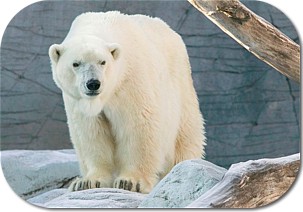 b) To provide an education facility dedicated to conservation of the Polar Bear and other Arctic wildlife. It will feature interpretive displays and other programs for zoo visitors and school classes, and will assist Polar Bears International and other zoos in facilitating and coordinating education programs.
b) To provide an education facility dedicated to conservation of the Polar Bear and other Arctic wildlife. It will feature interpretive displays and other programs for zoo visitors and school classes, and will assist Polar Bears International and other zoos in facilitating and coordinating education programs.
c) To act as a conduit between Polar Bear research and management programs in the Arctic and research being conducted in zoos and aquariums, again in cooperation with PBI programs already well advanced. It will also provide space and equipment for visiting researchers.
The third phase of development for Polar Bears at the Zoo is a series of three large exhibits on natural substrates, depicting various types of habitat occupied by this species along the Manitoba coast of Hudson Bay, such as marine beach meadow, gravel-beach ridge, bedrock outcrops, and muskeg. One of the exhibit sites will feature a building with underwater-viewing of bears, seals and ice floes, an Arctic marine-life aquarium, interpretive panels, an aurora borealis display on the ceiling, and space for educational programs. Opening in 2013, these exhibits and holding facilities will house up to six adult polar bears, including one or more breeding pairs.
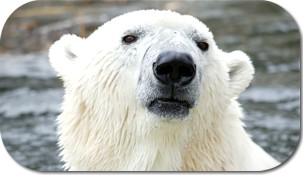 These new developments will draw the many tourists that arrive in Winnipeg each autumn en route to Churchill, Manitoba (the “Polar Bear Capital of the World”) to participate in Tundra Buggy Tours to observe dozens of Polar Bears gathering along the coast in anticipation of sea-ice formation. The Rescue Center, Research Center, and exhibits were made possible by a major grant from the Manitoba Government, and announced at a special “snow-turning ceremony’ held on June 8, 2010, attended by Manitoba Premier Greg Selinger, Conservation Minister Bill Blaikie, PBI President Robert Buchanan, and Assiniboine Park Conservancy Board Chairs Hartley Richardson and Don Stueber. Debby played a significant role in generating public, corporate and government support for these new facilities – a truly wonderful legacy for a cherished bear.
These new developments will draw the many tourists that arrive in Winnipeg each autumn en route to Churchill, Manitoba (the “Polar Bear Capital of the World”) to participate in Tundra Buggy Tours to observe dozens of Polar Bears gathering along the coast in anticipation of sea-ice formation. The Rescue Center, Research Center, and exhibits were made possible by a major grant from the Manitoba Government, and announced at a special “snow-turning ceremony’ held on June 8, 2010, attended by Manitoba Premier Greg Selinger, Conservation Minister Bill Blaikie, PBI President Robert Buchanan, and Assiniboine Park Conservancy Board Chairs Hartley Richardson and Don Stueber. Debby played a significant role in generating public, corporate and government support for these new facilities – a truly wonderful legacy for a cherished bear.
Dr. Robert Wrigley is the Curator at the Assiniboine Park Zoo. Trained as an ecologist, he held the positions of Curator of Birds and Mammals, and Museum Director, at the Manitoba Museum, and was the first Director of the Oak Hammock Marsh Interpretive Center in Stonewall, Manitoba. (Please see Update) |
References:
Weigl, R. 2005. Longevity of mammals in captivity; from the living collections of the world. Kleine Senckenberg-Reihe 48: 214 pp.
Wrigley, R.E. 2001. Polar Bear encounters at Churchill. Hyperion Press Ltd., 96 pp.
Photo Credits:
Photographs by Darelene Stack, the Assinibone Park Zoo and Doug Collicutt.
Carry on for other "At the Zoo" articles:
Blizzard the White Buffalo | Tale of a Wandering Spider
Visit the Zoo online at: www.assiniboineparkzoo.ca
| You can help NatureNorth produce more great articles with a secure donation through PayPal. Our Google Adsense ads pay our server costs, but that's about it. To learn more follow this link: Support NatureNorth. Thank-you! | |
Return to Winter Issue | NatureNorth Front Page

